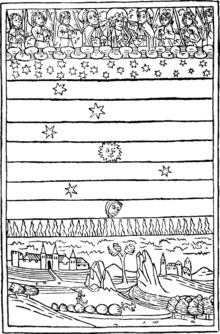
Back السماوات السبع Arabic السماوات السبع ARZ সপ্তস্বর্গ Bengali/Bangla Set cels Catalan Sedm nebes Czech هفت آسمان Persian Seitsemän taivasta Finnish Tujuh Langit ID Sette cieli Italian 7つの天国 Japanese

In mythological or religious cosmology, the seven heavens refer to seven levels or divisions of the Heavens. The concept, also found in the ancient Mesopotamian religions, can be found in Judaism and Islam. The Christian Bible does not mention seven levels of heaven. Some of these traditions, including Jainism, also have a concept of seven earths or seven underworlds both with the metaphysical realms of deities and with observed celestial bodies such as the classical planets and fixed stars.[1]
Beliefs in the plurality of the heavens were not restricted to the belief in seven heavens. Ancient near eastern cosmology largely accepted the existence of three heavens. In Jewish cosmologies (albeit absent from the Hebrew Bible), the number of heavens could range from 3 to 365, with 7 being the most popular figure.
- ^ Hetherington, Norriss S. (2014) [1993]. Encyclopedia of Cosmology: Historical, Philosophical, and Scientific Foundations of Modern Cosmology. Routledge Revivals. Routledge. pp. 267, 401. ISBN 978-1317677666.